Cambodia Essential
Travel Information
Getting there
Getting around
Visa & Entry Information
Money and Credit cards
Cambodia Map
|
Cambodia Travel Guide to Accommodation
|
|
Welcome to fascinating Cambodia

The greatest attraction in Cambodia Angkor is a vast
temple complex featuring the remains of several capitals of the Khmer
Empire, from the 9th to the 15th century AD. These include the famous
Angkor Wat temple |
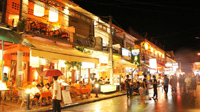
Charming gateway town to the world famous destination
of the Angkor temples. Siem Reap has transformed itself into a major
tourist hub. It is laid-back and a pleasant place to stay while touring
the temples. |
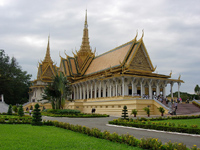
Capital of Cambodia a city with leafy boulevards,
take in the splendour of the Royal Palace and Silver Pagoda, while
the cream of ancient Khmer art is housed a stone’s throw away
at the National Museum. |
Sihanoukville
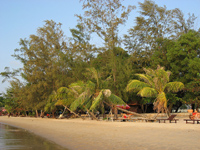
Sihanoukville, also known as Kampong Som, is a beach
resort with white-sand beaches and undeveloped tropical islands Sihanoukville
is a good place to relax and unwind, it can get very busy during holiday
season |
Kampot
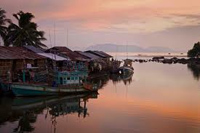
Kampot is a small town in south-east Cambodia Kampot's
main attraction is its relaxing riverside setting and the starting
point for trips to Bokor Mountain. You can travel to SihanoukVille
and Phnom Penh in a few hours, and to Vietnam in an hour from Kampot |
Battambang
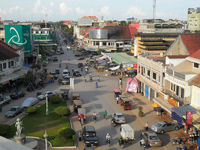
In northwestern Cambodia Battambang is the leading
rice-producing province of Cambodia, situated by the Sangkae River
the the French Colonial architecture is some of the best preserved
in Cambodia a a modern city with small-town friendliness |
Kratie
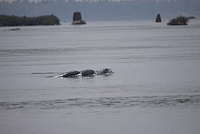
A tiny town in north eastern Cambodia relatively remote
and not heavily touristed but plenty backpackers pass through here
during the high season but the province is rural, so be mindful of
your behaviour be respectful and dont litter this unique place. |
Floating Village
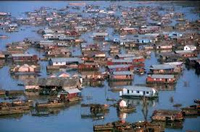
The Floating Village of Chong Khneas is an entire
community made up of wood structures that teeter on stilts over the
Tonle Sap just outside of Siem Reap A unique place that you will never
forget the lifestyle and the friendly villagers make for an incredible
experience |
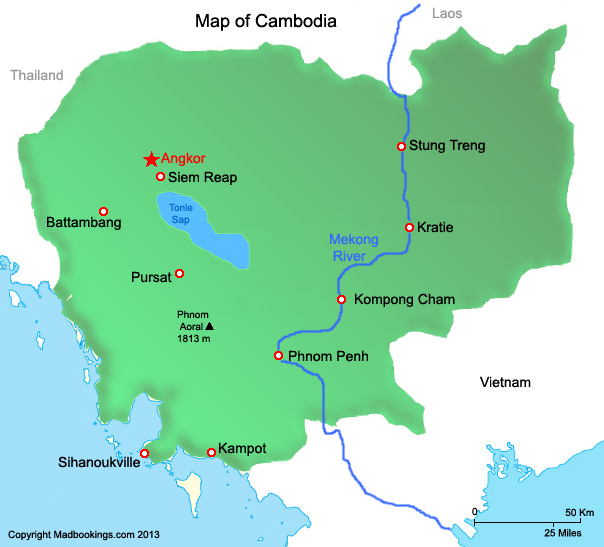
International borders are shared with Thailand and the Lao People’s
Democratic Republic on the West and the North, and the Social Republic
of Viet Nam on the East and the Southeast. The country is bounded on the
Southeast by the Gulf of Thailand. In comparison with neighbors, Cambodia
is a geographical contact country administratively composed of 20 provinces,
three of which have relatively short maritime boundaries, 2 municipalities,
172 districts, and 1,547 communes. The country has a coastline of 435
km and extensive mangrove stands, some of which are relatively undisturbed.
The dominant features of the Cambodian landscape are the large, almost
generally located, Tonle Sap (Great Lake) and the Bassac River Systems
and the Mekong River, which crosses the country from North to South. Surrounding
the Central Plains which covered three quarters of the country’s
area are the more densely forested and sparsely populated highlands, comprising:
the Elephant Mountains and Cardamom Mountain of the southwest and western
regions; the Dangrek Mountains of the North adjoining of the Korat Plateau
of Thailand; and Rattanakiri Plateau and Chhlong highlands on the east
merging with the Central Highlands of Viet Nam.
The Tonle Sap Basin-Mekong Lowlands region consists mainly of plains
with elevations generally of less than 100 meters.
As the elevation increases, the terrain becomes more rolling and dissected.
The Cardamom Mountains in the southwest rise to more than 1,500 meters
and is oriented generally in a northwest-southeast direction. The highest
mountain in Cambodia –Phnom Aural, at 1.771meters – is in
the eastern part of this range.
The Wet Season
The wet season comes courtesy of the southwest monsoon which blows from
May to October, bringing with it some 75% of Cambodia's annual rainfall.
Not surprisingly, the wet season is characterised by rain, and during
the peak of wet season from July to September it can rain as much as two
out of every three days. However, the rainy days are usually just a few
hours of heavy downpour and not all-day rain, although the latter do occur.
From a more cheerful perspective, monsoonal Cambodia is also a beautiful
country to travel around in. The roads are not dusty and the lush greenery
of the country returns. Angkor Wat in particular can be stunning during
the wet season -- the murals have a more unique appearance and feel. Observing
Angkor Wat with a lightning storm as a backdrop is an electrifying experience.
There are also fewer tourists going about in the country, so if you prefer
to dodge the crowds, wet season can be a good time to visit.
Regionally, the Cardamom Mountains get the heaviest rain in the country,
while the entire coastline gets rough seas and a lot of rain.
The Dry Season
The dry period runs from October to April, when the dusty northeast monsoon
arrives. Blowing like a hair-dryer set to high, the northeast monsoon
dries out the country very quickly. While November and January are quite
cool (high C20s) by April, the weather can be scorching and very dry.
Characterised by heat and dust, this season coincides with Cambodia's
peak tourist season when travellers arrive in their droves between November
and January to take advantage of the lack of rain, enjoy the sun and the
relatively cooler months.
Cambodia's beach strips at Kep, Sihanoukville and Ko Kong bask in brilliant
sunshine with clear calm waters and if you're a beach person, dry season
is the best time for you.
The Elephant Range, an extension of Cardamom Mountains, runs towards the
south and the southeast and rises to elevations of between 500 and 1,000
meters. These two range are bordered on the west are narrow coastal plain
facing the gulf of Thailand that contains Kampong Som Bay. The Dangrek
Mountains at the northern rim of Tonle Sap Basin, consisting of a steep
escarpment on the southern edge of the Korat Plateau in Thailand, marks
the boundary between Thailand and Cambodia. The average elevation of about
500 meters with the highest points reaching more than 700 meters. Between
the northern part of the Cardamom ranges and the western part of the Dangrek,
lies and extension of the Tonle Sap Basin that merges into the plains
in Thailand, allowing easy accesses from the border of Bangkok.
The Mekong River Cambodia’s largest river, dominates the hydrology
of the country. The river originates in mainland China, flows through
Myanmar, Laos, Thailand before entering Cambodia. At Phnom Penh, with
alternative arms, the Bassak River from the south, and the Tonle Sap River
linking with the " Great Lake " itself –Tonle Sap –
form northwest. It continues further southeastward to its lower delta
in Viet Nam and to the South China Sea.
The section of Mekong River passing through Cambodia lies within the
topical wet and dry zone. It has a pronounced dry season during the Northern
Hemisphere winter, with about 80 percent of the annual rainfall occurring
during the southwest monsoon in May-October. The Mekong River average
annual flow at Kratié of 441 km3 is estimated as 93 percent of
the total Mekong run-off discharge into the sea. The discharge at Kratié
ranges from a minimum of 1,250m3/s to the maximum 66,700m3/s.
The role of Tonle Sap as a buffer of the Mekong River system floods and
the source of beneficial dry season flows warrants explanation. The Mekong
River swells with waters during the monsoon reaching a flood discharge
of 40,000m3/s at Phnom Penh. By about mid-June, the flow of Mekong and
the Bassak River fed by monsoon rains increases to a point where its outlets
through the delta cannot handle the enormous volume of water, flooding
extensive adjacent floodplains for 4-7 months. At this point, instead
of overflowing its backs, its floodwaters reserve the flow of the Tonle
Sap River (about 120 km in length), which then has the maximum inflow
rate of 1.8m/s and enters the Grate Lake, the largest natural lake in
Southeast Asia, increasing the size of the lake from about 2,600 km2 to
10,00 km2 and exceptionally to 13,000 km2 and raising the water level
by and average 7m at the height of the flooding. This specificity of the
Tonle Sap makes it the only "river with return " in the world.
After the Mekong’s water crest (when its downstream channels can
handle the volume of water), the flow reverses and water flows out of
the engorged lake. The Great Lake then acts as a natural flood retention
basin. When the floods subside, water starts flowing out of the Great
Lake, reaching a maximum outflow rate of 2.0m/s and, over the dry season,
increase mainstream flows by about 16 percent, thus helping to reduce
salinity intrusion in the lower Mekong Delta in Viet Nam. By the time
the lake water level drops to its minimum surface size, a band 20-30 km
wide of inundate forest is left dry with deposits of a new layer of sediment.
This forest, which is of great significance for fish, is now greatly reduced
in size through salvation and deforestation. The area flood around Phnom
Penh and down to the Vietnamese border is about 7,000 km2.
Local Time
Cambodia runs at GMT +7 hours, the same time zone as its neighbors Thailand,
Vietnam and Laos.
Cambodian Currency
US dollars are as commonly used as the Cambodian Riel and even Thai Baht
is acceptable in many places. Most hotels and many restaurants and shops
set their prices in dollars. Small transactions are usually done in Riel.
Always carry some small Riel for motorcycle taxis, snacks, beggars and
other small purchases.
Riel notes come in 50, 100, 200, 500, 1000, 5000, 10,000, 50,000 and
100,000 denominations, but the distinctive red 500 Riel note is the most
commonly used.
Banks
There are banks in all provincial capitals in the country, including
Phnom Penh, Siem Reap, Sihanoukville, Kampot and Battambang. Banks offer
the usual banking services - cash advances on credits cards (most accept
Visa card,) international currency exchange, telegraphic transfers, cash
travelers checks and ANZ Royal Banks, Canadia and SBC Banks offer ATMs
with international access. Most banks are open from 8:00 to 15:00 or 16:00PM,
Monday through Friday. Some are open Saturday mornings until 11:30. ATMs
are available 24 hours.
Click here for bank listings and contact details.
Money Changers Money changers offer a slightly better rate that the banks.
They are plentiful and tend to cluster around the traditional markets
and there is usually a section within the market dedicated to moneychangers
and gold sellers.
When accepting US dollars in change, inspect the bills carefully. Marred
riel is acceptable tender, but the tiniest tear in a large US note, especially
a $20, $50 or $100 note, renders it all but useless in Cambodia. Banks,
moneychangers and other businesses will not accept it.
Credit Cards In the major tourist towns, credit cards are accepted at
most upscale hotels, shops and restaurants, some mid-range place and a
growing number of other businesses. Credit cards are general not accepted
at any businesses outside of Phnom Penh, Siem Reap, Sihanoukville and
the casinos in Poipet. Visa, MasterCard (MC) and JCB cards are the most
widely accepted credit cards in Cambodia. AMEX is coming into wider use,
as well as the new ANZ Bluespot card. Diners Club (DC) is accepted at
very few place. Most businesses charge a 2%-4% fee to accept credit cards.
ATMs There are now ATMs with international access in Phnom Penh, Siem
Reap, Sihanoukville, Kampot and Battambang. ANZ Royal Bank and Canadia
Bank ATMs both accept Cirrus, Plus, Maestro, Visa and MasterCard systems.
SBC Bank ATMs accept Visa and MasterCard. All ATMs dispenses US dollars.
There For locations see the ATM icons on the city maps.
Travelers Checks Travelers checks are accepted at most banks, major hotels
and restaurants and some money changers. AMEX in US dollars are the most
widely accepted travelers checks.
Cash Transfers 'Instant' cash transfers can be done through MoneyGram
or Western Union. Ordinary telegraphic transfers are available at all
major banks.
The climate can generally be described as tropical. As the country is
affected by monsoon, it is hot and humid with an overage temperature around
27.C (80.F). There are two distinct seasons: the Rainy Season and the
Dry Season. However, the Dry Season is divided into two sub-seasons, cool
and hot. These seasons are:
The Rainy season:
From June till October 27-35.C (80-95.f)
The Dry season (cool):
From November till February 17-27.C (80-95.F)
The Dry season (Hot) :
From March till May 29-38.C (84-100.F)
The advent of mobile phones has dramatically improved communications
between the main towns. That said, many of the landlines destroyed during
the Khmer Rouge era have yet to be replaced, and the lack of phone lines
not only hinders ordinary business but also keeps Internet access costs
high everywhere except Phnom Penh and Siem Reap. It's only been a few
years since mail destined for Cambodia had to be collected in Bangkok,
but the postal service is now reasonably reliable, although inbound letter
that attract the attention of staff-there's no rhyme or reason to this-often
get pilfered.
Mail
All Cambodia's mail is consolidated in Phnom Penh. Sending mail from
provincial cities seems as reliable as posting from the capital, though
it costs a little more as you'll be charged for your mail to go to Phnom
Penh first. Within the capital itself, only the main post office is geared
up to accept mail bound for abroad.
Mail to Europe, Australasian and North America takes between five and
ten days to arrive, leaving Phnom Penh for major international destinations
around twice a week the specific days can be checked at the main post
office. Stamps for postcards sent from the capital cost 1800 Riel to Europe
and Australia, 2100 Riel to America (add 300 Riel if posting from the
provinces).
Parcels can only be posted in Phnom Penh, though at a whopping $17 for
a one kilogramme parcel going abroad, it's worth deferring the task if
you are subsequently heading to Thailand. You'll be charge 3000 Riel for
the the customs form, detailing the contents and their value, to be completed,
but it isn't necessary to leave the package open for checking. Post offices
sell mailing boxes if you need them.
Phones
You can make domestic and international calls at post offices or telecom
offices in most towns. The government telecommunications network; Camintel
(W) (www.camintel.com) usually runs these services, which along with the
Australian firm Telstra, also runs public call boxes in Phnom Penh. To
use these, you'll need a phone card, available in denominations ranging
from $2 to $50; look for shops displaying the phone cards can't be used
in each other's facilities, but with a Tele 2 phone card, you can make
international calls from any call box by dialing the access code (T) 007
(instead of the usual (T) 001), then the country code and number as usual.
With any of these options, making international calls is expensive at
around $3 per minute, so It's worth looking out for deals offered by internet
shops, guesthouses and travel agents, which can as much as halve the cost.
For domestic calls only, the cut-price glass-sided booths, payable to
the attendant. The booths vary in their coverage of Cambodia's various
networks: accessible numbers will be written on the side of the booths
(usually (T) 012 MobiTel numbers - see below - plus the local area code
and sometimes other mobile providers).
Faxing is extortionate in Cambodia, at $3-$6 per page. If you really
must send a fax, the hotel business central and internet shops are the
most reliable place to do so.
Mobile Phones
There are five mobile phone service providers in Cambodia: MobiTel (T)
012, Beeline (T) 090, Smart Mobile (T) 010 & 016, Cube (T) 013, MetFone
(T)097. MobiTel is the most widely used network and has transmitters in
all major towns, although reception is still limited to within the town
boundaries.
Tourists can buy Sim Card for their mobile phones at arrival terminal
of all airports in Cambodia and border Checkpoint. Usage is by pre-paid
phone card, available in values from $2 to $100; in most towns, you'll
find outlets displaying the logos of the various providers. When you get
your card, scratch off the panel on the back to reveal your PIN, then
call up the top-up number-also given on the card-and enter the number
to activate the card. Call rates are around $0.20 per minute within the
same mobile network number or out to a local landline.
Internet access
If you want to get online, do it in Phnom Penh or Siem Reap - here you're
never far from an Internet shop or café and rates are under $1
per hour.
Currently free Wi-Fi is available at most hotels, restaurants, Mini Mart,
Café and shopping mall.
In the provinces it's a different matter: even in Battambang and Sihanoukville
access is limited, and expensive at around $3 per hour. One of the best
ways to keep in touch while traveling is to sign up for a free email address
that can be accessed from anywhere, for example Yahoo Mail, Gmail, Outlook
or Skype or Facebook. Once you've set up and send mail from any Internet
Café, or from a hotel with Internet access.
There are Internet Service Providers in Cambodia such as Online, AngkorNet,
Mekong Net, WirelessIp, Ezecom with reasonable price. Prepaid Internet
Card is available at any shops and super markets and price is starting
from $5 to $100.
The restaurants and café shop like the M Café, Café
Sentiment, T & C Coffee, Global Coffee, True Cofee, Kiriya Coffee
and more offer free internet access with WI-FI - there you just bring
your own laptop only.
Most Cambodians dress up casually except when they are attending formal
events. It is common to see men and women using Krama, a Long, Narrow
checked cotton cloth round their neck. The krama is just like a piece
of clothe.
Lightweight, loose-fitting, cotton clothing is recommended and long-sleeved
items should be included for protection from mosquitoes and the sun. During
the rainy season an umbrella is more convenient than a rain coast. A jacket
may be needed in hotels and restaurants using excessive air-conditioning.
Textiles
There are three important silk textiles in Cambodia. They include the
ikat silks (chong kiet in Khmer), or hol, the twill-patterned silks and
the weft ikat textiles. Patterns are made by tying natural and synthetic
fibers on the weft threads and then it is dyed. It is repeated for different
colors until the patterns firm and cloth is woven. Traditionally, five
colors are used. Red, yellow, green, blue and black are the most used.
The Sampot Hol is used as a lower garment and as the sampot chang kben.
The Pidan Hol is used as a ceremonial hanging used for religious purposes.
Sot silk weaving has been an important part of Cambodia's cultural past.
It has been documented that people from Takéo Province have woven
silk since the Funan era and records, bas-relief and Zhou Daguan's report
have shown that looms were used to weave sampots since ancient times.
Since ancient times, women have learned highly complex methods and intricate
patterns, one of which is the hol method. It involves dying patterns on
silk before weaving. What remains unique to Cambodian weavers is the uneven
twill technique, the reason remains unclear why they adopted such an unusual
method. The ancient bas-reliefs however provides a complete look at how
fabrics were like, down to patterns and pleats. Silk woven pieces are
used as heirlooms, in weddings and funerals, and as decoration in temples.
Sampot
The sampot is the national garment of Cambodia. The traditional dress
is similar to those worn in the neighboring countries of Laos and Thailand,
but variations do exist between the countries. The sampot dates back to
the Funan era when a Cambodian king allegedly ordered the people of his
kingdom to wear the sampot at the request of Chinese envoys.
There are many variations for the sampot, each is washed according to
social class. The typical sampot, known also as the sarong is typically
worn by men and women of lower class. It measures approximately one and
a half meters and both ends are sewn together. It is tied to safely secure
it on the waist.
Kroma - Khmer Scarf
Beneath the warm Cambodian sun, a person's productivity relies heavily
upon the suitability of one's dress. Since little is accomplished in blisteringly
hot clothes, Khmer people for generations have tied kromas around their
waists to work and play in cool comfort.
The Khmer scarf, woven from cotton or silk, has been a fashion staple
since Ancient times. While some claim the thin cloth, wrapped around one's
head or neck, is used primarily to wipe the sweat from a hot face, others
say wearing a kroma is as 'Khmer' as wearing a necktie is American.Srey
Yar Savdy, head of the Buddhist Institute's Mores and Tradition Department
in Phnom Penh said that the kroma has had a home in Cambodia since the
first century reign of Preah Bath Hun Tean. It is not clear when exactly
the kroma hit the streets, but it has been a symbol of the Khmer kingdom
and its people ever since.
"Nowadays, people are more particular and they like to have some
quality instead of the less expensive kroma they used to use," said
Channavy, the co-manager of a small weaving business. She said the demands
of discerning customers have compelled her to prepare her loom with greater
care in order to meticulously spin the cotton thread into a bobbin.
|









